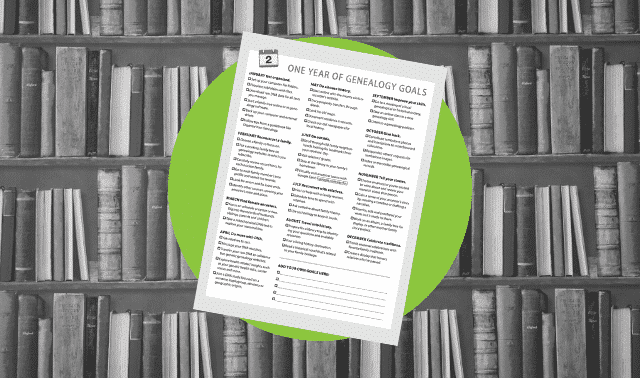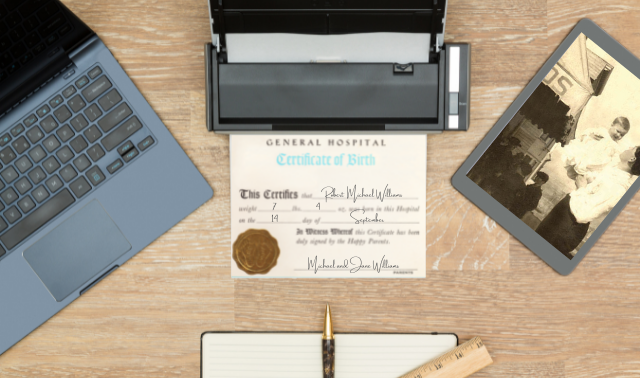Sign up for the Family Tree Newsletter! Plus, you’ll receive our 10 Essential Genealogy Research Forms PDF as a special thank you.
Get Your Free Genealogy Forms
"*" indicates required fields

In the last half of the 19th century, Briton Lewis Carroll and American L. Frank Baum created two of the most popular characters in all of fiction: Alice and Dorothy Gale. Carroll’s Alice influenced Baum’s Dorothy, but another similarity between the two characters is interesting. In Alice’s Adventures in Wonderland, we have the following exchange:
One day Alice came to a fork in the road and saw a Cheshire cat in a tree. “Which road do I take?” she asked. “Where do you want to go?” was his response. “I don’t know,” Alice answered. “Then,” said the cat, “it doesn’t matter.”
In Baum’s book The Wonderful Wizard of Oz, Dorothy’s first encounter with the Scarecrow doesn’t involve a choice of paths. In the well-known 1939 film, however, Dorothy comes to a crossroads and wonders which to way to go. The Scarecrow, somewhat unhelpfully, recommends both: “That way is a very nice way. It’s pleasant down that way, too. Of course, people do go both ways.”
At least Dorothy, unlike Alice, has a specific goal in mind: reaching the Emerald City. Dorothy settles on a path and (with some help) arrives at her destination.

Genealogists are often more like Alice than Dorothy. Lacking a clear goal, they have no basis for choosing the best research course. You might start out by engaging in genealogical research “just for the fun of it,” with no particular goal in mind. But then you come upon a hard-to-trace ancestor or you want to solve a family mystery (when did Great-great-grandpa come to America, anyway?). For this type of purposeful research, you’ll need to take an organized approach. That means knowing where you want to go in order to get there. In this excerpt from my book, Organize Your Genealogy, I’ll help you define what it is you want to accomplish—we’ll call it a “project”—and show you steps to organize your project so you can achieve your goal.
Choose Your Goals
Your goals for genealogy research largely depend on your experience level. For example, many genealogists for whom family history is a hobby choose research goals based on what they’d most enjoy. And beginning genealogists will probably want an initial goal that’s reasonably easy to attain.
As you gain education and experience, your preferences may turn toward more-challenging research goals. Try to choose a goal that has a realistically achievable and concrete outcome, and allows you to track your progress and remain motivated.
What might a genealogical goal look like? Here are some example projects:
- Take a particular surname line as back as far as you can. This goal is a bit tricky because it doesn’t have a built-in way to know when you’ve achieved it: How do you know when can go no further? But you could break down this goal into phases. For example, a first-phase goal might be identifying the line back to the immigrant ancestor, followed by a second phase of researching the records from the country of origin. With any luck, you may even find a distant cousin to work with.
- Identify all descendants of an ancestor. Often, investigating a specific ancestor can lead to finding previously unknown cousins. Some of these folks may share your enthusiasm for genealogy.
- Create a family tree for a reunion or event. Your goal might involve sharing your history with family members at a reunion, wedding, anniversary or birthday—for example, completing a certain number of generations back from a common ancestral couple or identifying all the known descendants of that couple. The event serves as a deadline to keep you motivated.
- Write about your family history. Although no genealogical research is ever technically “finished,” you can always publish updates or post your work online where it’s easy to revise. The tangible product you visualize—whether it’s a book, blog or something else—can serve as your goal.
Nothing says you need to restrict yourself to just one goal at a time, but you’ll want to be selective. If you’re working toward too many goals at once, you may find yourself jumping from one to another so often that you don’t make real progress on any of them. An ideal balance might be to have two or three genealogical goals at a time, letting you move between projects when you’ve hit a brick wall or have temporarily lost interest in one of them.
And there’s nothing wrong with putting a research goal on hold, returning to it later with fresh eyes and more experience. Sometimes the records you need to make progress on your goal aren’t yet readily available, or your project requires a research trip that will have to wait until life circumstances permit you to go.
Break Down Each Project
Goals and the steps to achieve them can be intimidating, especially when they require a lot of work and won’t produce a final result for months or even years. In the case of a genealogical project, you may be especially intimidated if you’re new to the field or have limited time to research.
The best way to attack an ambitious goal or project is to break it down into smaller sub-projects. When I first envisioned my book, for example, I knew I’d first need to create an outline so I could define the content of each chapter. My publisher asked to see a more-detailed outline to further subdivide each chapter. Once I had that detailed outline, I realized I could complete the book one chapter at a time, and each chapter, one section at a time.
In the same way, almost any genealogical project can be broken down. Instead of trying to tackle learning about all eight great-grandparents at once, focus on smaller, more immediate tasks, such as finding an application for Social Security (SS-5) form for one ancestor and an obituary for another.
If the entire project has a deadline, you can give each sub-project its own deadline, too. This will not only maintain your momentum toward accomplishing the project, but also provide a way to determine whether the project is going according to plan.
Not sure how to subdivide a project? Depending on the type of project, you could focus on the generation, geography, genealogy or some combination of these:
- Generational sub-projects encourage you to focus on one generation at a time. This may seem obvious, but consciously focusing on one generation at a time as you work backward prevents you from overlooking your ancestors’ siblings (whose records are an important source of family information, not to mention a path to distant cousins) before you move on to the next generation.
- Geographical sub-projects focus your research on a particular geographical area, useful because documents are usually filed and preserved together in repositories at a national, state or local level. This can save time when you’re using a set of records from a particular place—you can look for records of any individual associated with the area, regardless of what generation he’s in.
- Genealogical sub-projects are based on tracing particular family lines, such as a sub-project for each child of an ancestor. This ensures that each descendant gets the proper research and isn’t overlooked.
For example, I might have a genealogy project called Research my eight great-grandparents. First, I need to identify them by name, so I’ll subdivide this project genealogically into Link father to his parents and Link mother to her parents. Another sub-project might cover linking each grandparent to his or her parents.
Set Tasks for Each Sub-Project
Once you have your goal, the project(s) to achieve it and the sub-projects to make it more manageable, you still need to get down to the level of specific actions you can take during a given research session.
Even a sub-project will take some time and consist of many individual tasks—you might think of them as steps—and each task may take a few minutes or a few hours to complete (anything longer should probably be split into multiple tasks). Whether you call them activities, tasks or to-dos, you’ll need to plan what they are in order to accomplish your goal.
My sub-project to link my father to his parents requires research into records created during that period that would document his relationship to his parents—for example, I’ll add a task of Locate and scan father’s SS-5 because I know an SS-5 will name his parents. I’ll also add Look for father in 1940 census, and create similar tasks for the 1930 and 1920 censuses. These should show my father in a household with his parents. I also want to add tasks for finding other kinds of records, such as birth certificates, marriage certificates, death certificates and obituaries.
So how do you keep track of all those tasks? Perhaps you’ve been tracking your genealogy to-do list or research log for years using a notepad. Some people use a daily planner to record errands for a given day.
Paper-based to-do systems can be difficult to review and search. It’s hard to move tasks from one date to another and hide completed tasks so they don’t distract you from what remains to be done. Also, with a paper-based system, you must have your physical to-do list with you, whether you’re at home or the library.
A paperless system delivers a lot of benefits by using applications that keep your research log online. You can access your to-do list on your desktop computer, laptop, tablet, smartphone or even a smartwatch. You can search for tasks by keyword and reorganize your list as needed. The best to-do list apps let you set deadlines (if the project or task has one) and reminders, and a “defer date” so you won’t even see a task on your list until the day you’ve set aside for it.
There are countless to-do applications, ranging from free to expensive. Some, such as Evernote and Microsoft OneNote, have free versions you can upgrade to premium for more features. Some genealogists set up a spreadsheet using the free Google Drive. I use a personal task-management app for Mac OS and Apple devices called OmniFocus, which unfortunately doesn’t have a free option (beyond the 14-day trial). You may need to play with several different tools until you settle on one that best fits your needs and research practices.
Once you’ve defined your projects, sub-projects and tasks, pull out your calendar, view it with your to-do system and schedule the parts you can schedule. I often use the “all-day” field at the top of my calendar’s daily view to list the two or three things I want to accomplish or focus on that day. The text can even be the name of a sub-project, showing me which task in that sub-project I should work on next.
In some cases, you’ll want to schedule a task for a particular time. For instance, you might know the best time to reach your cousin on the phone is during the noon lunch hour. Another option is to simply block out large chunks of time (one to two hours) for a particular sub-project, which will motivate you to work on that without getting distracted by other, equally fun genealogical work. Don’t forget to schedule breaks. It’s easy to forget to eat or stand up when you’re on a research roll.
If you’re the type of person who benefits from reminders and won’t find them too annoying, set up alerts on your calendar so you’ll be notified of what to work on at any given time. You may need to turn off notifications from other systems (such as Facebook) so you won’t be tempted to leave your research and spend that time on social networking. Don’t worry: There’ll be plenty of time for that once you’re done.
Monitor Your Progress
Any good project management system should incorporate a way for you to easily see how you’re doing. You want to be motivated by what you’ve already accomplished and quickly see what you need to do in the coming days, weeks and months.
At least once a year, review each of your projects. This doesn’t have to happen at the end of the year, when you might be busy with holiday-related activities or using your free time to research. Rather, set your “annual review” for about a year from the start of your project.
As you conduct your review, try to answer a few questions for each project: What progress have you made? If none, have you lost interest? What’s left to do? Do these remaining items need to be further broken down into more-manageable steps?
Yearly
Your annual review is also a good time to consider future genealogy projects: Do you have ideas for new ones? Of course, you can add projects at any time, but it’s helpful to assess how you’re doing on your current projects before adding new ones to your list. Reviewing your genealogical research on an annual basis will ensure that the projects you’re engaged in continue to hold your interest. It’ll also help you determine how long your research projects are taking. Finally, seeing your movement from simpler projects to more complex ones will help you document your growth as a genealogist.
Monthly
You should also plan to do a monthly review of your projects. As with scheduling the annual review, there’s no need to do your monthly review on the first of every month. Pick whatever date works best for your schedule. This monthly review is when you can determine whether a particular project is making progress or has stalled—and why. Perhaps a repository has failed to respond to a document request you made, and you need to follow up. Or maybe you realize you’ve been neglecting a project, so you could either decide to set it aside for awhile or resolve to devote more time to it.
Weekly
Finally, you’ll also want to do a quick weekly review to look over what you’ve done in the past week and schedule items you want to work on in the coming weeks. When I pull up my eight great-grandparents project, I can see which tasks I’ve completed, which I can work on now, and which ones can be deferred to a later date. If the only task for this project that I can work on now is the one involving locating and scanning my father’s SS-5, I should do so, then mark it complete in my to-do system.
Again, while performing this research task, additional to-dos may arise, so I should be ready to add them if needed. For instance, if I were to realize that I don’t have a copy of my father’s SS-5, but I think my brother might, I would create a new task, Contact Jeff for Dad’s SS-5.
Write in your annual, monthly and weekly reviews on your calendar, preferably on the same day of the week and at the same time so it becomes a part of your routine. OmniFocus lets me indicate the date of each project’s next review and how often I want to review it (such as monthly); your system may have a similar option.
A good way to maintain your progress on any research project is to talk about it with someone. Perhaps you have a genealogy friend or a family history enthusiast relative you can call or visit regularly to share your latest findings. Knowing that your friend will be asking how your projects are going will give you additional motivation to honestly review your work, identify any problems and keep working to achieve your genealogy goals.
11 Possible Genealogy Goals
Let these suggested genealogy goals inspire your research:
- Identify the immigrant ancestor in each family line
- Locate your family’s ancestral hometown overseas
- Identify an adopted ancestor’s biological parents
- Discover where a particular relative is buried
- Answer a specific family history question, such as “Are we related to a Mayflower Pilgrim?” or “Did Great-great-grandfather really work on the transcontinental railroad?”
- Apply for membership in a lineage society, such as the Daughters of the American Revolution
- Learn about Grandpa’s experience serving in World War II
- Trace the provenance of a family heirloom
- Figure out who’s who in an old, unidentified photo
- Research a family home or farm
- Create life timelines for your four grandparents
Tip: When you come across a source or record not related to the project you’re working on, enter it as a “to-do” item in your research log and come back to it later.
A version of this article originally appeared in the July/August 2016 issue of Family Tree Magazine. Last updated: January 2025
FamilyTreeMagazine.com is a participant in the Amazon Services LLC Associates Program, an affiliate advertising program designed to provide a means for site to earn advertising fees by advertising and linking to affiliated websites.









